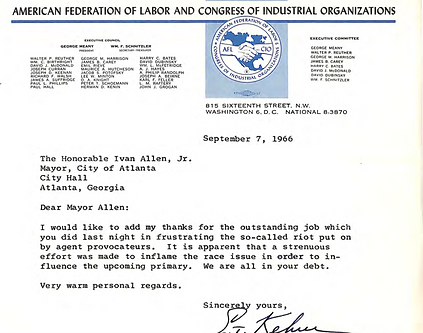SUMMERHILL RIOTS
SUMMERHILL RIOTS
On September 6, 1966, an unarmed black man, Harold Prather, was shot by a white police officer. While the police claimed they had a warrant for Prather’s arrest, his neighbors grew furious, and a riot broke out in the streets of Summerhill.
Mayor Ivan Allen appeared on the scene immediately after news broke out.
As Mayor of Atlanta from 1962 to 1970, Ivan Allen played a large role in the Civil Rights movement. While Allen advocated for both the white and black communities of Atlanta, he has glorified his role as a Civil Rights leader.
Allen believed he served as a trusting leader for the African American communities, while in reality, he was viewed as a powerful white male who showed interest for these communities for political gain.
Consequently, when the Summerhill riots broke out, Mayor Ivan Allen tried to use his power to take control of the chaos by calming the residents, which backfired in his direction. Explore the following documents from the Ivan Allen digital archive to examine Allen’s actions and the many responses he received.


One of the notorious pictures of Mayor Ivan Allen Jr. during the Summerhill Riots.
The dinner held to honor Martin Luther King Jr. after he was awarded the Nobel Prize.
Mayor Allen's Reaction to Summerhill Riots
Because Allen truly envisioned himself as a Civil Rights leader, he headed straight for Summerhill when he riots broke out. Initially, Allen took a nonviolent approach to try and reason with the rioters to go home and fight for compromise in a peaceful manner. Perhaps the most infamous example of Allen at the riots is when he decided to stand on top of a cop car to calm the crowd.
Pictures from Ivan Allen Jr.'s memoir, Mayor: Notes on the Sixties, where Allen portrays himself as the city's saving grace, although the crowd mostly ignored him.

Mayor Allen's Account:
“Somebody said I should get on top of the police car and try to talk to them, so I was handed a bullhorn and boosted up on the hood, and I struggled to the roof of the car while the crowd alternately cheered and jeered. I knew I had made a serious tactical mistake the minute I stood atop that car, alone and vulnerable and exposed, a prosperous-looking Northside businessman with a good suit and well-tanned cheeks, looking down at the mob of two thousand people taunting me and zeroing in on me.”

Call to Action
After hours, none of the demonstrators had calmed down, with some protesters beginning to throw bricks at other citizens and police officers. Mayor Allen ordered the police to fire into the air and set off tear gas, despite advocating heavily for peaceful negotiation. While Allen and many other officials felt this was necessary, the rioters felt this was an act of superiority, hate, and injustice.
An excerpt from Black Power in the South depicting
how sixth-grader, Colombus Ward, was particular frightened by the tear gas, exclaiming that:
"I thought they were shooting bullets at first."
Response to Mayor Allen's Actions
Thousands of letters swarmed Allen’s office, congratulating him on his “heroic efforts” that were seen in the face of a “dangerous” situation. A large majority of these letters were written by white Atlantans, informing Allen of how proud they were and how he was guaranteed their votes. Allen also received national recognition, as the mayors of other prominent cities wrote to share their approval. The American Federation of Labor and Congress of Industrial Organizations, located in D.C., even went as far as to thank Allen for his bravery.

 |  |
|---|---|
 |  |
 |  |
 |  |


Documents reflecting the "other side" of the riots and the African American community's reaction to use of violence on the Summerhill protesters.

While Allen did receive some letters of disapproval, they were much less prominent, and focused on the abuse of his power.

While Mayor Allen is portrayed as a hero for his "intervention" within the riots, SNCC, the Student Nonviolent Coordinating Committee is blamed for the riots.
Learn more about SNCC's role